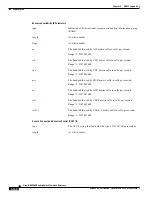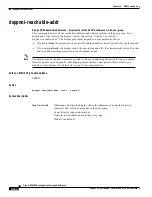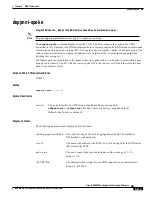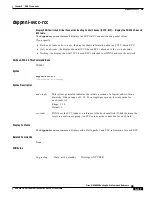
5-110
Cisco MGX 8850 Routing Switch Command Reference
Release 2.0, Part Number 78-10467-04 Rev C0, October 2001
Chapter 5
PNNI Commands
dsppnni-routing-policy
Related Commands
cnfpnni-routing-policy
On demand routing
The current rule for on-demand routing is firstfit or bestfit.
The firstfit routing policy selects the first route found that goes to the
destination. The time for finding a route is the least possible, but the optimal
route may not be selected.
The bestfit policy selects a route based on:
•
The least-cost route, where the sum of all administrative weights in both
directions of the route must be less than maxCost.
•
Link verification.
•
Path constraint checks.
•
Avoidance of blocked nodes and links.
•
Checking limits in the designated transit list (DTL).
SPT path holddown
time
The minimum time that can elapse between consecutive calculations that
generate routing tables on border nodes.
Units: 100 milliseconds.
Range: 1 (0.1 seconds)–600 (60 seconds).
Note
The current release does not support border nodes, so this value
must remain off.
AW Back-
ground Table
The flag that enables or disables administrative weight (AW) for the
background routing table. The AW is the cost to traffic that traverses that path.
The metric AW can be specified on the interface and by the service class (or
QoS class), and it is associated with each link. AW is a defining factor when
routes are selected. The AW parameters influence how PNNI selects paths in
the peer group, and therefore how it distributes each SVC and SPVC. PNNI
route selection can also key on AW to exclude certain links from routing, such
as defining a backup link for use only when there is no available bandwidth on
the primary link.
The AW for a path is the sum of all AWs at each port egress for both directions
on the path.
CTD Back-
ground Table
The flag that enables or disables cell transfer delay (CTD) for the background
routing table. CTD is the time interval between a cell exiting source node and
entering the destination node.
CDV Back-
ground Table
The flag that enables or disables cell delay variation (CDV) for the background
routing table. CDV is a component of cell transfer delay, and is a quality of
service (QoS) delay parameter associated with CBR and VBR service. Cell
Delay Variation is the variation of delay between cells, measured peak to peak.
















































